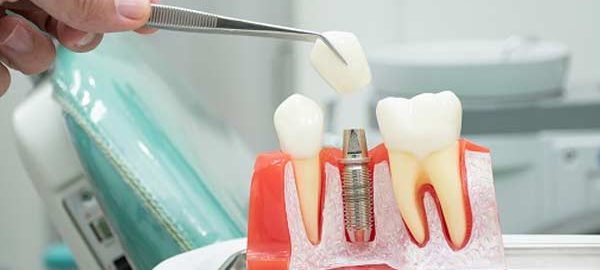Replace missing teeth with a removable or fixed solution on teeth, but cheaper.
THIS TREATMENT IS FOR YOU IF…
You need to replace several teeth.

What are prosthetics?
Dental prostheses are devices created to measure for the patient to restore the loss of one or several teeth and thus recover dental functionality and aesthetics.
The dental technician prepares them following the instructions of the dentist, who is the only one who is qualified and empowered to place the prostheses on the patient. They can be made with acrylic, porcelain, and various other metals.
What types of prosthetics exist?
Depending on their location in the mouth and whether they are fixed or removable, the prosthesis is classified as:
- Removable prosthetics. They can be partial or complete.
- Fixed prosthetics on teeth.
- Prosthetics on dental implants. Which in turn, can also be fixed or removable.
Removable prosthetics
They are those that the patient himself can remove to wash them. Depending on the teeth that need to be replaced, removable dentures can be partial or complete.
- Partial removable dentures. They are those that are used when the patient retains some of his original teeth, and the others are replaced by prostheses. Three types are distinguished:
- Resin prosthetics. Manufactured only in this material and are mainly supported by the gum.
- Dental skeletal prostheses. Metal alloy structure with a combination of resin that is fixed to the gum and adjacent teeth by means of metal hooks that transmit greater pressure to the teeth that support it.
- Valplast or flexite prosthesis. Composed of biocompatible nylon that provide an ideal degree of flexibility and stability.
- Complete removable prostheses. They are those that are placed when the patient does not retain or cannot retain any teeth, so the prosthesis replaces all the teeth in the arch. They cover the upper palate for better retention, and occupy the entire bony crest.
Fixed prosthetics on teeth
Fixed prostheses are those that the patient cannot remove, not even to sanitize them, the dentist being the only one who should do it. They are anchored on the teeth adjacent to the absence, so they must first be carved to make room for the crown that will be placed on them later, this is the only disadvantage.
Advantages of prosthetics
The placement of prostheses to restore lost or damaged teeth has numerous benefits, both aesthetic and health. They stand out among them:
- Recover the lost smile. The restoration of the teeth with a prosthesis allows to recover the aesthetics and the smile.
- Improved self-esteem. Recovering the smile usually gives the patient more confidence, allowing them to establish better social and work relationships.
- Better chewing. By recovering the teeth, the chewing function that is usually affected by damaged teeth is also recovered. With chewing, digestion is therefore improved and with it general health.
- Prevent tooth mobility. Recovering the teeth closes the space that the adjacent teeth can occupy, avoiding having to resort to other treatments such as orthodontics.
- Pronunciation improvement. The diction improves when all the teeth are recovered, since the tongue and the movements of the mouth are more natural and some sounds such as those of the letters t and d require the teeth for their pronunciation.
- Better oral hygiene. Having all the teeth facilitates the hygiene of both the teeth themselves and the entire mouth, avoiding other related problems such as halitosis.
Phases of prosthesis treatment
The stages of prosthesis treatment depend on the type of prosthesis of each patient. In the case of using a prosthesis on dental implants, the procedure will first require a detailed study before the surgical intervention to place the implants. However, they all have several phases in common.
These are the phases that all prosthesis treatment shares:
- Study of the patient. Whether the prostheses are placed on the teeth, mucous membranes or on an implant, the first step will always be an analysis by a specialist of the state of the patient’s mouth. This study will serve to check the health of the mouth and the feasibility of the treatment to be carried out.
- Preparation of the mouth. Depending on the type of prosthesis that is going to be placed on the patient, the preparation will be different. When the prosthesis is placed on the teeth, these may need to be carved for the correct placement of the prosthesis. When placed on implants, the surgical procedure of an implant treatment will have to be performed first.
- Preparation of the new teeth in the laboratory. The prostheses, in most cases, are manufactured by a dental technician under the instructions of the dentist who will adapt and place them. The prostheses are always personalized, so it is essential that the dentist requests them from the laboratory tailored to the patient.
- Placement of the prosthesis. Once the mouth is prepared, the prostheses will be placed. As explained in the section on types of prostheses, this phase will depend on whether it is fixed or removable, partial or complete, or whether it is placed on the teeth or on implants.
- Maintenance and sanitation. In order for the new teeth to remain in good condition, it will be very important to properly clean and care for them. When they are removable prostheses, this can be done by the patient himself, while if they are fixed, the specialist must do it. In any case, it will always be very important to maintain good oral hygiene habits.



 Caries is the most common oral disease in our society, so fillings are a very common treatment.
Caries is the most common oral disease in our society, so fillings are a very common treatment.
 What does a dental cleaning consist of?
What does a dental cleaning consist of?






 Endodontics is a treatment for severely infected or decayed teeth caused by part of the nerve of the tooth. The treatment consists of repairing and saving the teeth by removing the dental pulp, and then cleaning and sealing the inside of the tooth. Dental pulp is the tissue inside the tooth that contains blood vessels, nerves, and connective tissue.
Endodontics is a treatment for severely infected or decayed teeth caused by part of the nerve of the tooth. The treatment consists of repairing and saving the teeth by removing the dental pulp, and then cleaning and sealing the inside of the tooth. Dental pulp is the tissue inside the tooth that contains blood vessels, nerves, and connective tissue.
